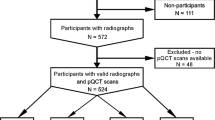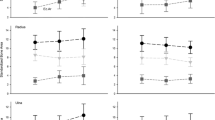Abstract
Bone geometry is an important measure of bone strength and is known to be affected by weight-bearing and adult ageing. Engagement in weight-bearing activity decreases with age, thus in this study we compared bone geometry changes between weight-bearing (tibia) and non-weight-bearing (fibula) leg bones in three different age groups of women. Magnetic resonance images of the right leg were acquired in 9 young (20–27 years), 7 old (61–69 years) and 7 very old (71–80 years) women. Total and cortical bone volumes and medullary cavity volumes (mm3) were calculated at proximal and distal sites for both bones. Tibial cortical bone volume was significantly less at the proximal site in old (17%) and very old (24%) groups versus young subjects. Cortical bone volume in the proximal fibula was also significantly reduced in the older groups (7 and 12%), but to a substantially lesser extent than in the tibia. In contrast, distal bone geometry appeared largely to be conserved in both tibia and fibula. Proximally, medullary cavity volume was greater in the older groups in the tibia but not the fibula. Distally, the only difference found in either bone was a significantly greater fibular medullary cavity in the very old group. These findings suggest weight-bearing bones in women are more susceptible than non-weight-bearing bones to age-related changes in bone geometry likely due to decreases in weight-bearing activities. Also, weight-bearing activity appears to provide a greater osteogenic stimulus at the distal portions of the leg bones.


Similar content being viewed by others
References
Azevedo MR, Araujo CLP, Reichert FF, Siqueira FV, Cozzensa da Silva M, Hallal PC (2006) Gender differences in leisure time physical activity. Int J Public Health 52(1):8–15
Beck TJ, Ruff CB, Khem B (1993) Age-related changes in female femoral neck geometry: implications for bone strength. Calcif Tissue Int 53:S41–S46
Bennell KL, Malcolm SA, Khan KM, Thomas SA, Reid SJ, Brukner PD, Ebeling PR, Wark JD (1997) Bone mass and bone turnover in power athletes, endurance athletes, and controls: a 12-month longitudinal study. Bone 20(5):477–484
Bouxsein ML, Myburgh KH, van der Meulen MC, Lindenberger E, Marcus R (1994) Age-related differences in cross-sectional geometry of the forearm bones in health women. Calcif Tissue Int 54(2):113–118
Caspersen CJ, Pereira MA, Curran KM (2000) Changes in physical activity patterns in the United States, by sex and cross-sectional age. Med Sci Sports Exerc 32(9):1601–1609
Consensus Development Conference (1993) Diagnosis, prophylosus and treatment of osteoporosis. Am J Med 94:646–650
Duncan RL, Turner CH (1995) Mechanotransduction and the functional response of bone to mechanical strain. Calcif Tissue Int 57:344–358
Fried LP, Fleg JL, Gundy E, Tobin JD, Fozard JL (1989) Physical activity patterns of adults: changes by age and sex. Gerontol 29 (special issue):192A
Frost HM (1997) On our age-related bone loss: insights from a new paradigm. J Bone Miner Res 12:1539–1546
Frost HM (2003) Bone’s mechanostat: a 2003 update. Anat Rec 275A:1081–1101
Garn SM, Frisancho AR, Sandusky ST, McCann MB (1972) Confirmation of the sex difference in continuing subperiosteal apposition. Am J Phys Anthropol 36:377–380
Geusens P, Dequeker J, Verstraeten A, Nijs J (1986) Age-, sex-, and menopause-related changes of vertebral and peripheral bone: population study using dual and single photon absorptiometry and radiogrammetry. J Nucl Med 27(10):1540–1549
Gordon GS, Vaughn C (1976) Clinical management of osteoporosis. HM and M, Aylesbury
Hamrick MW, Skedros JG, Pennington C, McNeil PL (2006) Increased osteogenic response to exercise in metaphyseal versus diaphyseal cortical bone. J Musculoskelet Neuronal Interact 6:258–263
Jiang HX, Majumdar SR, Dick DA, Moreau M, Raso J, Otto DD, Johnston DW (2005) Development and initial validation of a risk score for predicting in-hospital and 1-year mortality in patients with hip fractures. J Bone Miner Res 20:494–500
Klein CS, Allman BL, Marsh GD, Rice CL (2002) Muscle size, strength, and bone geometry in the upper limbs of young and old men. J Gerontol A 57:M455–M459
Martin RB, Pickett JC, Zinaich S (1980) Studies of skeletal remodeling in aging men. Clin Orthop Relat Res 149:268–282
Martini F, Nath JL (2009) Fundamentals of anatomy and physiology 8e. Pearson Education Inc, San Francisco
McMillan SJ, Marsh GD (2002) Humeral and femoral shaft geometry in young and old men. Med Sci Sports Exerc 34:S59
McNeil CJ, Raymer GH, Doherty TJ, Marsh GD, Rice CL (2009) Geometry of a weight-bearing and non-weight-bearing bone in the legs of young, old, and very old men. Calcif Tissue Int 85:22–30
Meema HE, Bunker ML, Meema S (1965) Loss of compact bone due to menopause. Obstet Gynecol 26(3):333–343
Melton JL, Riggs BL, Achenbach SJ, Amin S, Camp JJ, Rouleau PA, Robb RA, Oberg AL, Khosla S (2006) Does reduced skeletal loading account for age-related bone loss? J Bone Miner Res 21(12):1847–1855
Myers ER, Hecker AT, Rooks DS, Hipp JA, Hayes WC (1993) Geometric variables from DXA of the radius predict forearm fracture load in vitro. Calcif Tissue Int 52:199–204
Netter FH (1987) Musculoskeletal system: anatomy, physiology, and metabolic disorders. Ciba-Geigy Corporation, Summit
Raisz L (2005) Pathogenesis of osteoporosis: concepts, conflicts, and prospects. J Clin Invest 115(12):3318–3325
Riggs BL, Melton LJIII, Robb RA, Camp JJ, Atkinson EJ, Peterson JM, Rouleau PA, McCollough CH, Bouxsein ML, Khosla S (2004) Population-based study of age and sex differences in bone volumetric density, size, geometry, and structure at different skeletal sites. J Bone Miner Res 19:1945–1954
Ruff CB, Hayes WC (1988) Sex differences in age-related remodelling of the femur and tibia. J Orthop Res 6(6):886–896
Szulc P, Seeman E, Duboeuf F, Sornay-Rendu E, Delmas PD (2006) Bone fragility: failure of periosteal apposition to compensate for increased endocortical resorption in postmenopausal women. J Bone Miner Res 21(12):1856–1863
Takebe K, Nakagawa A, Minami H, Kanazawa H, Hirohata K (1984) Role of the fibula in weight-bearing. Clin Orthop Relat Res 184:289–292
Vilhjalmsson R, Kristjansdottir G (2003) Gender differences in physical activity in older children and adolescents: the central role of organized sport. Soc Sci Med 56(2):363–374
Woodhead HJ, Kemp AF, Blimkie CJR, Briody JN, Duncan CS, Thompson M, Lam A, Howman-Giles R, Cowell CT (2001) Measurement of midfemoral shaft geometry: repeatability and accuracy using magnetic resonance imaging and dual-energy X-ray absorptiometry. J Bone Miner Res 16:2251–2259
Author information
Authors and Affiliations
Corresponding author
Additional information
Communicated by Susan A. Ward.
Rights and permissions
About this article
Cite this article
Allen, M.D., Johnstone, J., Rice, C.L. et al. Differences in leg bone geometry in young, old and very old women. Eur J Appl Physiol 111, 2865–2871 (2011). https://doi.org/10.1007/s00421-011-1902-7
Received:
Accepted:
Published:
Issue Date:
DOI: https://doi.org/10.1007/s00421-011-1902-7




